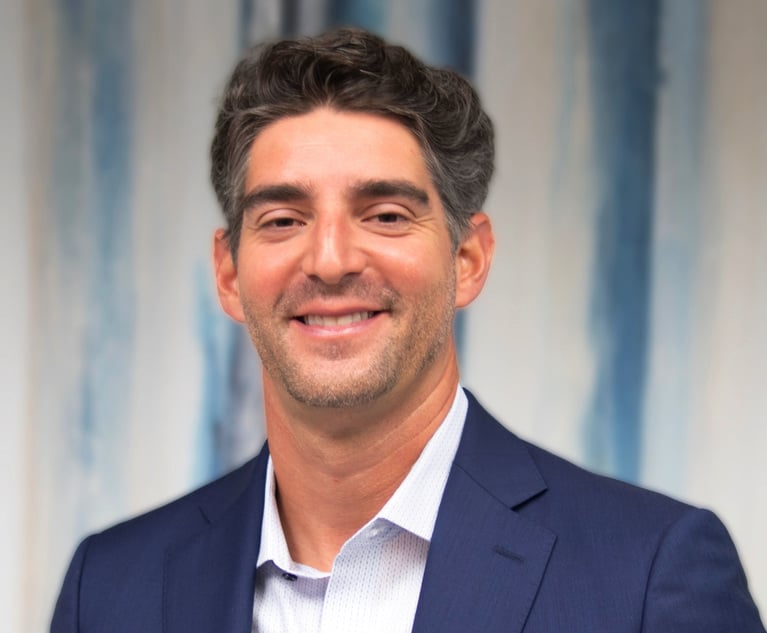Tossed Again, Snapchat Speed Filter Crash Case Back Before Court of Appeals
The suit seeks to hold Snapchat responsible for a wreck caused by a driver trying to use the app's Speed Filter feature to record herself driving 100 miles per hour.
June 16, 2020 at 06:19 PM
4 minute read
 Naveen Ramachandrappa, Bondurant Mixson & Elmore, Atlanta. Photo: John Disney/ ALM
Naveen Ramachandrappa, Bondurant Mixson & Elmore, Atlanta. Photo: John Disney/ ALM
Once again, a lawsuit brought by a man seriously injured when he was hit by a young driver trying to record herself doing 100 miles an hour on Snapchat's "Speed Filter" was before the Georgia Court of Appeals on Tuesday, and once again, the judges were asked to revive it after a trial court threw it out.
Attorneys for the plaintiff and Snapchat drew starkly different pictures of what legal responsibility the instant messaging app could have for the accident, with plaintiffs lawyer Naveen Ramachandrappa arguing that Snapchat users often play a "dangerous game" of trying to capture images of themselves going 100 mph or faster, and that the company tacitly "encouraged" the practice.
There have been multiple instances of serious and fatal accidents caused by drivers using the feature, he said, and young drivers are particularly susceptible to the app, which allows them to "live in the moment" by posting a still or video of the high-speed maneuver, which shortly vanishes.
"You can send something dangerous to your friends and, poof, it goes away," said the Bondurant Mixson & Elmore partner.
Jonathan Blavin of San Francisco's Munger, Tolles & Olson represents Snap Inc., which makes the app.
Blavin said the company had no responsibility for drivers who ignore its warning to obey traffic laws, and that arguments that it "encourages" reckless driving are both unsupported and cannot be used to establish causation or any duty to its users.
Blavin told the appellate panel of Judges Sara Doyle, Christopher McFadden and Ken Hodges that a California court ruling in a similar case had found the allegation "too vague and speculative" to sustain a cause of action.
The case began in 2015 when 18-year-old Christal McGhee was reportedly using the Speed Filter as she drove her father's Mercedes-Benz C230 in Clayton County.
She was doing over 100 when she lost control and slammed into another car driven by Wentworth Maynard, who was severely injured.
Maynard and his wife sued California-based Snapchat for negligence and loss of consortium in Spalding County State Court.
In 2016 Judge Josh Thacker dismissed it, finding that the claims were barred by the federal Communications Decency Act; the Court of Appeals reversed that ruling and sent it back to him.
The case was back before the court after Thacker again dismissed it, based on his finding that Snapchat had no duty to either driver, and did not proximately cause the accident.
In Tuesday's arguments, Ramachandrappa came under some questioning as to why the app could be blamed for McGhee's accident.
"Why do you contend that it's the Snapchat Speed Filter rather than the speedometer on the vehicle or the gas pedal?" Hodges asked.
Ramachandrappa pointed to a 2016 article about Speed Filter's popularity among teen drivers, which mentioned that "the act of looking at a speedometer is not as fun" as posting your high-speed Snaps.
"The app links you to your friends, so it's not just riding in your car; it's sharing it with your friends," he said.
Georgia case-law has repeatedly said a defendant could be liable for third party's actions if the risk is foreseeable, he said.
"We see it all the time," he said, pointing to verdicts allowing Six Flags to be held accountable for an attack near its gates, and a case where a company that made asbestos-containing products was held liable for injuries to an employee's daughter.
Courts have repeatedly found that manufacturers can be held liable for damages caused by their products, even if they were used in unintended ways, he said.
Blavin said the Speed Filter was designed neutrally and could be used for any number of purposes, including someone in an airplane timing its speed or beachgoers sharing a laugh by showing their speed at zero.
Even if there were some indication that someone might misuse the app, he said, no proximate cause can be laid at Snapchat's feet.
There is "no duty under the law to design a product to render it totally harmless," Blavin said.
This content has been archived. It is available through our partners, LexisNexis® and Bloomberg Law.
To view this content, please continue to their sites.
Not a Lexis Subscriber?
Subscribe Now
Not a Bloomberg Law Subscriber?
Subscribe Now
NOT FOR REPRINT
© 2025 ALM Global, LLC, All Rights Reserved. Request academic re-use from www.copyright.com. All other uses, submit a request to [email protected]. For more information visit Asset & Logo Licensing.
You Might Like
View All
From Courtrooms to Conversations: The Unexpected Joys of Podcasting as a Lawyer


'A Fierce Battle of Expert Witnesses' Expected in Cybersecurity Spat

14-State Coalition Sues TikTok, Alleging Addictive Algorithms Trigger Mental Health Harms in Adolescents
Law Firms Mentioned
Trending Stories
Who Got The Work
J. Brugh Lower of Gibbons has entered an appearance for industrial equipment supplier Devco Corporation in a pending trademark infringement lawsuit. The suit, accusing the defendant of selling knock-off Graco products, was filed Dec. 18 in New Jersey District Court by Rivkin Radler on behalf of Graco Inc. and Graco Minnesota. The case, assigned to U.S. District Judge Zahid N. Quraishi, is 3:24-cv-11294, Graco Inc. et al v. Devco Corporation.
Who Got The Work
Rebecca Maller-Stein and Kent A. Yalowitz of Arnold & Porter Kaye Scholer have entered their appearances for Hanaco Venture Capital and its executives, Lior Prosor and David Frankel, in a pending securities lawsuit. The action, filed on Dec. 24 in New York Southern District Court by Zell, Aron & Co. on behalf of Goldeneye Advisors, accuses the defendants of negligently and fraudulently managing the plaintiff's $1 million investment. The case, assigned to U.S. District Judge Vernon S. Broderick, is 1:24-cv-09918, Goldeneye Advisors, LLC v. Hanaco Venture Capital, Ltd. et al.
Who Got The Work
Attorneys from A&O Shearman has stepped in as defense counsel for Toronto-Dominion Bank and other defendants in a pending securities class action. The suit, filed Dec. 11 in New York Southern District Court by Bleichmar Fonti & Auld, accuses the defendants of concealing the bank's 'pervasive' deficiencies in regards to its compliance with the Bank Secrecy Act and the quality of its anti-money laundering controls. The case, assigned to U.S. District Judge Arun Subramanian, is 1:24-cv-09445, Gonzalez v. The Toronto-Dominion Bank et al.
Who Got The Work
Crown Castle International, a Pennsylvania company providing shared communications infrastructure, has turned to Luke D. Wolf of Gordon Rees Scully Mansukhani to fend off a pending breach-of-contract lawsuit. The court action, filed Nov. 25 in Michigan Eastern District Court by Hooper Hathaway PC on behalf of The Town Residences LLC, accuses Crown Castle of failing to transfer approximately $30,000 in utility payments from T-Mobile in breach of a roof-top lease and assignment agreement. The case, assigned to U.S. District Judge Susan K. Declercq, is 2:24-cv-13131, The Town Residences LLC v. T-Mobile US, Inc. et al.
Who Got The Work
Wilfred P. Coronato and Daniel M. Schwartz of McCarter & English have stepped in as defense counsel to Electrolux Home Products Inc. in a pending product liability lawsuit. The court action, filed Nov. 26 in New York Eastern District Court by Poulos Lopiccolo PC and Nagel Rice LLP on behalf of David Stern, alleges that the defendant's refrigerators’ drawers and shelving repeatedly break and fall apart within months after purchase. The case, assigned to U.S. District Judge Joan M. Azrack, is 2:24-cv-08204, Stern v. Electrolux Home Products, Inc.
Featured Firms
Law Offices of Gary Martin Hays & Associates, P.C.
(470) 294-1674
Law Offices of Mark E. Salomone
(857) 444-6468
Smith & Hassler
(713) 739-1250






